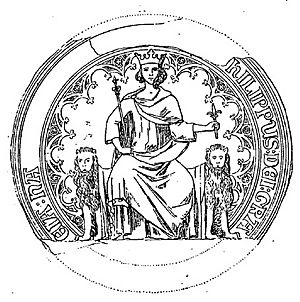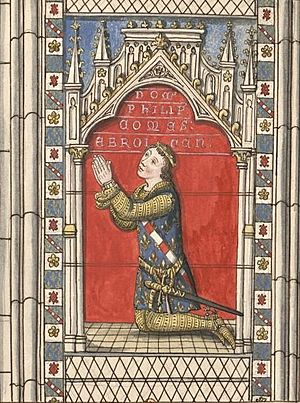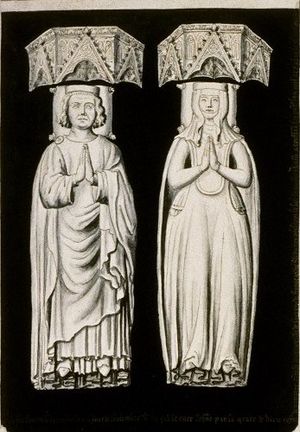Philip III of Navarre facts for kids
Quick facts for kids Philip III |
|
|---|---|

Bust in the Louvre, originally from the Jacobin convent which housed Philip's heart
|
|
| King of Navarre (jure uxoris) with Joan II (1328-1343) |
|
| Reign | 1 April 1328 – 16 September 1343 |
| Coronation | 5 March 1329 |
| Predecessor | Charles I |
| Successor | Joan II |
| Born | 27 March 1306 |
| Died | 16 September 1343 (aged 37) |
| Burial | Pamplona Cathedral |
| Spouse | Joan II, Queen of Navarre |
| Issue more... |
Maria, Queen of Aragon Blanche, Queen of France Charles II, King of Navarre Philip, Count of Longueville Louis, Duke of Durazzo |
| House | House of Évreux |
| Father | Louis, Count of Évreux |
| Mother | Margaret of Artois |
Philip III (born March 27, 1306 – died September 16, 1343), also known as the Noble or the Wise, was the King of Navarre from 1328 until his death. He was born into a less powerful branch of the French royal family. However, he became very important when the main line of the Capetian royal family in France ended. This allowed him and his wife, Joan II of Navarre, to become rulers of the Kingdom of Navarre. They also gained control of several French lands called fiefs.
Philip and Joan becoming rulers meant the end of a 44-year period where France and Navarre were ruled by the same person. This is called a personal union. Even though they didn't become rulers of France, Philip and Joan were powerful nobles under the French King Philip VI of France. They were also very successful co-rulers in Navarre. At first, some people in Navarre didn't want Philip to be king alongside Joan. But Philip is praised for making the kingdom's laws better. The royal couple mostly lived in their French lands. However, they spent enough time in Navarre to become very popular there.
Philip actively helped his French cousin, King Philip VI, with his soldiers. He also led armies, especially when the Hundred Years' War began. During his time as co-ruler with Joan, Navarre started to focus more on its neighbors in Spain. This might have led Philip to join a holy war, called a crusade, against the Kingdom of Granada. He became sick during this crusade, possibly from a wound, and then he died.
Contents
Early Life and Royal Connections
Philip was the son of Louis, Count of Évreux. Louis was a younger son of King Philip III of France. Philip's father started the House of Évreux, a branch of the Capetian royal family. His mother, Margaret of Artois, also came from another Capetian family branch.
The House of Évreux was involved in talks about who would rule after King Louis X of France. When Louis X died suddenly in 1316, his only child was a four-year-old daughter named Joan II of Navarre. This was a problem because no Capetian king had ever died without a son. Joan's mother's family wanted her to be queen. But her uncle became King Philip V of France instead. He also took over the Kingdom of Navarre, which had recently come under French rule.
King Philip V was later convinced to make a deal about his niece Joan's future. An agreement in 1318 included giving Joan some lands. It also arranged for her to marry Philip of Évreux. She was promised more lands if King Philip V died without a son. Philip and Joan married on June 18, 1318. Joan was only six years old at the time. They lived near each other but were not raised together because of their age difference. They officially became husband and wife in 1324.
Philip became the Count of Évreux in Normandy when his father died in 1319. Since Philip was still young, his uncle, Charles of Valois, became his guardian.
King Philip V died without a son in 1322. All his lands went to his younger brother, Charles IV of France. Charles IV married Philip's sister, Joan of Évreux, in 1325. When Charles IV also died without sons in 1328, the direct male line of the House of Capet ended.
Because Joan (Philip's wife) and Philip V's daughters were passed over, the rule that only sons could inherit the throne became stronger. This is called agnatic succession. Philip of Évreux and his cousin, Philip of Valois, were the strongest candidates for the French throne. King Edward III of England also claimed it, as he was Charles IV's nephew. However, Edward's claim was rejected. Philip of Valois, who was 35, was chosen over Philip of Évreux, who was 23, because he was older.
So, the House of Valois began to rule France with King Philip VI. He immediately asked Philip of Évreux to join his royal council. However, the Valois family had no right to the Kingdom of Navarre or the French regions of Champagne and Brie. These lands belonged to Joan's family. King Philip VI didn't want Philip and Joan to have Champagne and Brie. These lands, along with their lands in Normandy, would surround his capital city of Paris. So, Philip and Joan gave up these lands. In return, they received other French lands: Angoulême, Mortain, and Longueville.
When Charles IV died in February 1328, Philip's wife Joan could finally claim the throne of Navarre. No one could challenge their right to it anymore. The people of Navarre were happy to see the personal union with France end. They had been unhappy with French governors. In March and May, the Navarrese assembly recognized Philip's wife, Joan, as their ruler. The start of the House of Évreux with Philip III was important. It marked a new time in Navarre's history, as it was now free from French rule again.
While everyone agreed Joan had the right to be queen, Philip's role was not clear. At first, only Joan was invited to the capital city of Pamplona to take over the government. Philip was ignored, but he wanted to show his authority. The couple talked with the Navarrese assembly separately in July. On August 22, Pope John XXII issued a special order, called a papal bull, confirming Philip as King of Navarre.
A big concern was Philip's part in the upcoming coronation. The assembly insisted that only Joan, as "the natural lady," would be raised on the shield and crowned. They said "no one can be raised up if they are not the natural lord." Still, they agreed to let Philip take part in the government. Philip was not happy. He believed his position would be weakened if he wasn't crowned with Joan. The couple's representatives argued for Philip's rights as "husband and head." They also said that Joan, as queen, wanted him to be crowned and have more power as her co-ruler.
In the end, both Joan and Philip were crowned. They were also blessed with holy oil by Bishop Arnalt de Barbazan. They were raised on the shield in Pamplona Cathedral on March 5, 1329. Philip and Joan were the first monarchs of Navarre to have a coronation ceremony. Using crowns and scepters was new for Navarre's royal ceremonies. It was borrowed from French traditions.
In May 1329, Philip and Joan signed a document. It stated many times that Joan was the "true and natural heir" of Navarre. But it also said that "all of the kingdom of Navarre would obey her consort under the name of king." Philip's role in helping his wife gain the kingdom smoothly was also recognized. To limit Philip's power, it was agreed that both he and Joan would give up the crown when their heir reached age 21. If they didn't, they would have to pay a large fine. This rule, limiting how long monarchs could rule, was very unusual.
Philip was the grandson of a king. But he grew up expecting to be just a count. So, he took his role as king very seriously. He was not ready for the job at all. Yet, he managed to learn everything he needed to know about his new kingdom in just a few months. This included its people, language, and government. All this happened while he was also advising the new King of France.
Philip III turned out to be a very good and successful ruler. His most famous achievement was improving the kingdom's laws, called the Fueros of Navarre, in 1330. In September 1331, he and Joan moved back to France. They returned to Navarre in April 1336 and stayed until October 1337. Philip III and Joan II spent more time in Navarre than any Navarrese ruler since 1274.
The couple spent most of their time in their French lands and their palace in Paris. From there, they could strengthen their position as important French nobles. But Philip made sure they were seen in Navarre during several visits. He even visited Navarre by himself sometimes. Meanwhile, Joan, the "natural lady" of Navarre, managed his own counties in France.
Philip III and Joan II worked closely together as rulers. But Philip often made the final decisions in laws and other government areas. Many royal orders were issued in both their names. However, Philip signed most of them without mentioning his wife. Only a few were issued in Joan's name alone.
The couple made sure that Navarre's customs and laws were respected. They also made sure that the kingdom's citizens were more involved in government. They were actively involved in running Navarre, even when they were away. They also put Navarre's interests before those of their French homeland. For this, they were praised by people at the time and by historians.
Philip and Joan started projects to help the economy. They built an irrigation system in the dry fields of Tudela in the south of their kingdom. They also repaired old castles and built a new one in Castelrenault. The king and queen also made sure laws were followed. They punished those who caused anti-Jewish riots that happened before they arrived. They also made sure victims received help. A big problem for them was banditry, which they worked to stop when they first started ruling. Their dedication to justice led writers to describe them as "a good king and queen and well loved by all in their kingdom."
In 1338, Philip took control of the lands of Mixe and Ostabarret. These lands had belonged to the viscounts of Tartas in Guyenne. These viscounts had paid homage to the king of Navarre for the lands. In 1338, the old viscount died. His successor, Bernard Ezi IV, refused to pay homage to Philip. So, Philip sent his officer to take over the main town of Mixe and manage the area. The local nobles were unhappy with this. In September, a small army was sent to restore order. Philip added these lands and their income to the royal treasury.
Foreign Relations and Crusades
In August 1328, Philip, who had just been recognized as King of Navarre, joined the King of France. They helped put down a peasant revolt in Flanders. At the Battle of Cassel on August 23, the army helping Philip VI was divided into ten groups. King Philip VI himself led one group. Philip III was with him, leading his own soldiers.
After this, Navarre's foreign policy under Philip III and Joan II turned back towards Spain. Even though they were still involved in French politics, the couple wanted to build stronger ties with the neighboring kingdoms of Aragon and Castile. From 1329 to 1333, they discussed a marriage alliance with Aragon. Their oldest child, a daughter named Joan, was supposed to marry King Peter IV of Aragon. However, during these talks, two sons, Louis and Charles, were born. They became the next in line for the throne instead of their sister. Joan later became a nun. The alliance with Aragon still happened in 1338 when Peter married Philip and Joan's second daughter, Marie.
From 1328 to 1331, Philip III of Navarre and Philip VI of France talked with Alfonso XI of Castile about a crusade against the Kingdom of Granada. But the action was put off because the French king was not ready. In 1333, a special sermon was given in Paris about a crusade. After the sermon, the King of France, along with the King of Navarre and other important nobles, promised to go on a "holy voyage overseas" to take back the Kingdom of Jerusalem. This crusade was eventually aimed at Granada. But because of problems in Europe, it was delayed indefinitely in 1336.
In late June 1335, while Philip was in France, Navarre's border was crossed by Castile several times. This led to war by October. Neither Philip nor Alfonso wanted the war. But Alfonso felt he had to lead his army against Navarre. Philip sent an archbishop to negotiate peace, and Alfonso quickly agreed. A peace treaty was signed in 1336. Navarre had received military help from Gaston II, Count of Foix. After the war, Philip ordered his treasury to pay the count for his help.
The question of who would rule France was not fully settled by Philip of Valois becoming king. In 1337, Edward III of England decided to claim the French throne. He was the closest male relative of Charles IV. In December 1339, at the start of the Hundred Years' War, Philip III of Navarre sent more soldiers to the city of Tournai. This was because an English attack was expected. He was with Philip VI of France and their allies, John of Bohemia and David II of Scotland, for the war's first campaign. The French king lifted the sieges of Cambrai (October 8, 1339) and Tournai (September 25, 1340).
Crusade and Death
Philip returned to Navarre in 1342 and again in 1343. This was partly to get ready for joining the crusade against the Muslim state of Granada. He likely felt this was his duty as the ruler of a kingdom in Spain. Philip's officials made sure that his own Muslim subjects in Tudela were not bothered by his crusading army.
Philip arrived at the siege of Algeciras in July 1343. He brought 100 knights and 300 foot soldiers. But more important was the large amount of food he sent from the Bay of Biscay. When Gaston II of Foix, an ally of Navarre, left the siege in late August, he tried to convince Philip to leave too, but Philip stayed.
In early September, Philip became ill. Some reports say he was wounded by an arrow. Alfonso XI offered him his own doctors. They advised Philip to change his diet. However, the King of Navarre preferred his own doctor's advice. His doctor told him to keep eating meat and wine and to leave the siege. He left as told, but he only made it to Jerez de la Frontera. There, he died on September 16, 1343. His body was brought back to Pamplona for burial. His heart was buried in a church in Paris that no longer exists. His wife, Joan, received a letter of sympathy from Pope Clement VI in November. Algeciras fell in March 1344. Joan continued to rule alone until her death in 1349. Then, the crown passed to their oldest living son, Charles II.
Family
Unlike other royal marriages, there is no special record of Philip and Joan's personal relationship. This suggests their marriage was neither especially close nor difficult. However, they were very rarely apart. They had nine children together:
- Joan (around 1326–1387), who became a nun.
- Maria (around 1329 – 1347), who was the first wife of Peter IV of Aragon.
- Louis (1330–1334).
- Blanche (1331–1398), who was the second wife of Philip VI of France.
- Charles II the Bad (1332–1387), who became the next king. He was also Count of Évreux.
- Philip, Count of Longueville (around 1333–1363), who married Yolande de Dampierre.
- Agnes (1334–1396), who married Gaston III, Count of Foix.
- Louis (1341–1376), who was Count of Beaumont-le-Roger. He married Maria de Lizarazu and later Joanna, Duchess of Durazzo.
- Joan (after 1342–1403), who married John I, Viscount of Rohan.
Family tree
See also
 In Spanish: Felipe de Évreux para niños
In Spanish: Felipe de Évreux para niños






